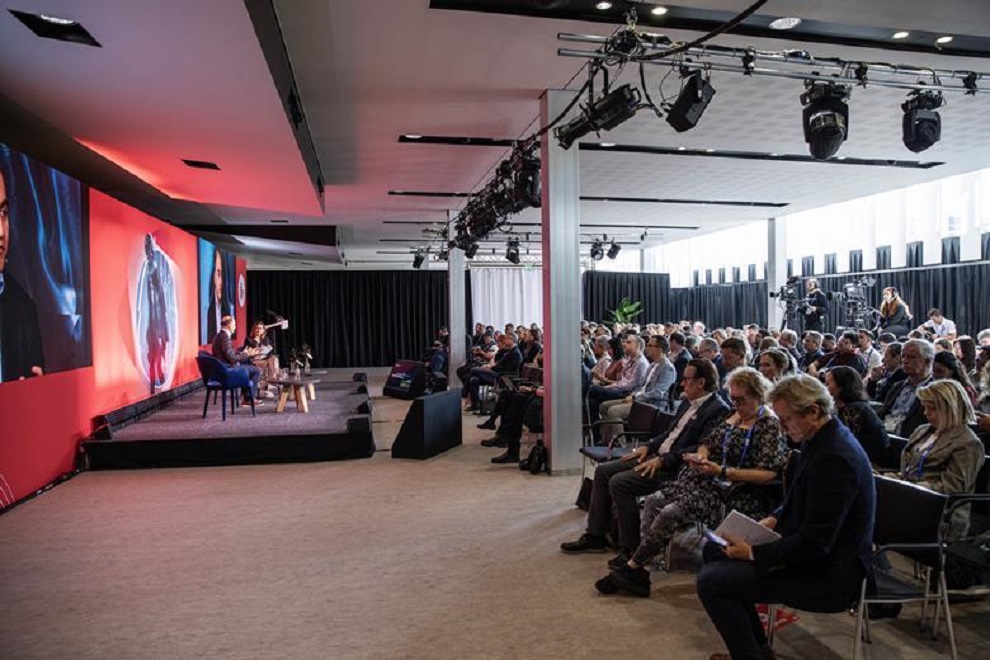By: Stuart Thomson
Phil Wiser, EVP and Global CTO, Paramount and Girish Bajaj, VP, Prime Video and Amazon MGM Studios Technology reflected on key trends in the CTO panel
Predicting moments of disruption are very hard, but the video business seems to be at a moment of inflection point, according to Phil Wiser, EVP and global CTO, Paramount.
Speaking on the CTO Perspectives panel at the IBC conference, Wiser pointed out that the video business had taken longer to arrive at this inflection point than the music business, which, with basically a single monetisation model, had been uniquely vulnerable to the revolution initiated by Napster, with iTunes and Spotify delivering the death blows.
“In less than 10 years, most of music consumption was shifted to the new model,” said Wiser.
Print with its ad-based model had been “stickier”, he said, while in the case of video, the legacy model had been protected by the fact that it generated good revenue streams tied to physical infrastructure.
“We are just at a point where the erosion of that has really started,” he said, predicting an acceleration in the decline of the traditional pay TV model, from now on.
Media businesses not already leaning into a converged model “are behind” the curve, he said. Having parallel broadcast and streaming businesses “no longer works”, he added.
To support the economics of the business, broadcast and streaming need to be converged, said Wiser.
He said that this applied to all media companies, including those that focus purely on content creation. The latter will need internet marketing skills and will need to create a greater amount of content in this new age.
Paramount had made a huge effort “to push into the cloud” and reengineer broadcast teams so they look like internet engineering teams.
The push to “internet everywhere on the inside”, he said, had helped break down the barrier between broadcast and digital distribution, with as much as possible migrated to public internet infrastructure.
“The internet is the most robust media distribution system ever built,” he said.
To achieve this cloud migration it was necessary to overcome resistance based on narrow financial analytics, and to follow intuition.
One part of the transformation was to partner aggressively with big scale players like AWS, which invested alongside Paramount in its cloud infrastructure. Paramount alone could not have invested the “hundreds of millions of dollars required”, said Wiser, adding that this lesson now applies even more to investment in AI.
“It is only going to get tougher from here in terms of operating margins. You have to figure out how to make the cost more fungible for new technologies,” he said.
Investment in AI
Nevertheless, investment in AI shows signs of paying off. With AI, he said, there is “no need to overinvest in data science or data teams”, even if it was important to have data capability.
“My data science team is probably going to shoot me [for that comment],” he said.
Wiser said media companies spend most time creating content and then marketing it. Production takes longer and it is hard to effect change in this area, he said. Now with AI, it is possible to create some change. However, it is unlikely to replace large parts of the creative process.
There is also little point in spending a lot of money investing in foundation models at this stage. It makes more sense to partner for “off the shelf AI” in this environment, he said.
Girish Bajaj, Prime Video
In a sit-own fireside chat as part of the CTO session, Girish Bajaj, VP, Prime Video and Amazon MGM Studios Technology, said the “most fun” he has in his job is expanding the line-up of content on the platform as well as working with partners such as Paramount and others who offer their service as subscription offerings on the Amazon Prime Video service.
His objective is to make Prime to “go to destination” for video streaming, he said.
Bajaj said media companies have to keep investing in what is important – high availability of the service and good picture quality.
Over the past couple of years, Amazon has invested in ways to help customers find content and cut the amount of time they spend doing this. “Our product is really reducing the amount of time spent to find content,” he said.
Amazon has been using AI for over 20 years in video and is now extending that to tap into the potential of Generative AI. “We are definitely leaning into it. The important part is everyone is trying to find the chatbot that is going to work.”
Generative AI is now being used for personalisation.
However, using AI for practical use cases meant reskilling and retooling the entire Prime Video team. He said the technology could be used for customer facing features but also on the back end to help process media files and create cover art, for example.
At the end of the session, Wiser joined Bajaj on stage to take Q&A, which again touched on the use of AI, specifically to improve recommendation.
Bajaj said the challenge was “leveraging data in the right way”. Using AI to understand both the customer and especially the content is important to get the pairing accurate, and that by doing so would improve personalisation.
Wiser meanwhile said it was a “fallacy” that we understand what consumers want based on the use of algorithms. There was a need for a more engaging conversation with consumers to understand what they want to watch.”
Source: IBC












